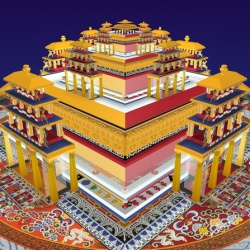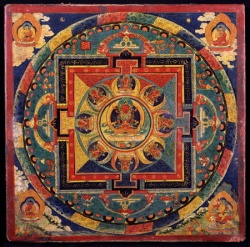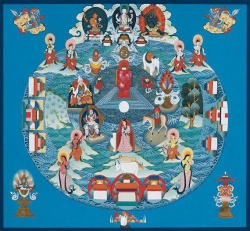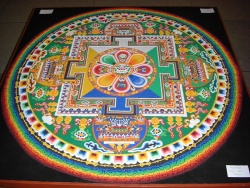The Philosophy of the Mandalas
The Mahavairocana Sutra and Vajrasekara Sutra explain the theories of Garbhakosa and Vajradhatu Mandalas. Both of the Mandalas have different Buddhas, Dharanis, Mudras and seedsyllables.
The Tathagatas of the Five Directions Garbhakosa:
- Central Mahavairocana Buddha
- East Ratnaketu Buddha (Precious Pennant Tathagata)
- South Samkusumitarajaha Buddha (The Flower Spreading King Tathagata)
- West Amitabha Buddha (Infinite Light Buddha)
- North Divyadundubhimeganirghosa Buddha (Thunderous Sound of the Heavenly Drum)
The Tathagatas in the Five Directions Vajradhatu:
- Central Mahavairocana Buddha
- East Aksobhya Buddha
- South Ratnasambhava Buddha
- West Amitabha Buddha
- North Amoghasiddhi
The philosophy of Garbhakosa begins with the Great Fulfillment Realm and ends with the Dharma Realm of Wisdom. It is the other way around with the Vajradhatu Mandala.
The Buddhas of the Garbhadhatu
In the middle ah, to the
east a, to the south a, to the
west am, and to the north ah
1. The Garbhakosa Mandala
According to the Mahavairocana Sutra: The seed-syllable or bija “A” in Sanskrit is the east direction. It is the best direction as it represents the Boddhi-citta (Awakened mind). It also means to start an action. The Bodhi-citta is the primary condition guiding other virtues, similar to the general's pennant that is used to command his troop. This belongs to Ratnaketu (Precious Pennant Tathagata) who resides in the East of the Eight-Petal Dais. The next bija (A) means Bodhi virtue. It belongs to the Samkusumitarajaha Buddha (The Flower Spreading King Tathagata). He resides in the Southern area of the Eight-Petal Dais. He is compared to a fully blossomed wisdom flower. The wisdom flower can only fully blossom when it has both the Bodhi-citta and the practice of the ten virtues. The bija “Am” means achievement of the Bodhi-citta. It belongs to Amitabha Buddha in the west. Amitabha is the Bliss Body, representing the fruit of successful practice of Buddhahood, which is the enjoyment of incomparable true happiness.
The Five Buddhas of the Vajradhatu In the middle vam, to the east hum, to the south trah, to the west hrih and to the north ah The bija “Ah” means entering nirvana. It also means a way. It belongs to Divyadundubhimeganirghosa Buddha. He resides in the area north of the Eight-Petal Dais. Following enlightenment, instead of enjoying its result, the Buddha used the Wisdom of Perfect Action to create skillful means to save sentient beings. He also used the same means to enter Nirvana when his task was done. The Essay on Bodhi-citta said: “Amitabha Buddha, enjoying the fruits of Buddhahood following his successful practice of the Bodhicitta” has the same meaning as “Divyadundubhimeganirghosa Buddha entering Nirvana following the completion of his tasks”. The bija “AH” (Or O) means having all the skillful means. This belongs to Mahavairocana. He resided in the center. Only the Buddhas can understand the sublime transcendent essence and the Eight-Petal Flower of Mahavairocana's world. Because of his vow, Mahavairocana had opened the Sutra of Great Compassion to guide living beings into the Buddha's mind. He used Adhistana to express himself in the body, speech, and mind of the people in this samsara (world of life and death).
The Vajradhatu Mandala: The Five Wisdom Tathagatas
Amoghasiddhi - AH
Amitabha - HRIH Aksobhya - HUM
Ratnasambhava - TRAH
2. The Vajradhatu Mandala
It is the Mandala of the five Wisdom Tathagatas: Vairocana symbolizes the nature of the Dharma Realm. The bija of Vairocana is “Om”. It represents the limitless universal experiences. Om, like other bijas, carries the force of creation. The Mandala carries the theory of the creation of the original Word, and the theory of world vibrations. Of the five skandas, Universal Consciousness is related to Vairocana. One person's consciousness becomes the Universal Consciousness when the limitless Dharma nature is experienced. The Universal Consciousness is represented by the blue color (both deep and dark blue) of limitless space. It is the first and foremost condition of existence, because it conserves all
without discrimination. Space in this case has to do with the sum of spiritual experiences and of the five aggregates as a whole.
It is not reserved for the aggregate of form in the mathematics of space. In this Mandala, Mahavairocana is at the center. His body is pure white. He sits on a lion throne. His Mudra is the gesture of setting the wheel of Dharma in motion (Dharma Cakra Mudra). Aksobhya Buddha symbolizes the intelligence of the Great Fulfillment Realm. His seed-syllable is “Hum”, which symbolizes the unification of essence and achievement. “Om” and “Hum” have complementary values of experience and as metaphysical symbols. Om” is liberation and “Hum” is salvation. “Om” goes into the All,
the Infinite, and “Hum” from the Infinite to the deepest part of the soul. The human factor and the sentiment of “Hum” transform Buddha to Bodhisattva, a lower rank, but of greaterhelp. “Hum” is the infinity in the finite, the
Aksobhya - HUM
timeless in the time, the
eternity in the moment, the
formlessness in the form
(Form is emptiness;
emptiness is form).
Aksobhya is the mystic Buddha in the five Dhyani Buddhas. He represents two aspects of Emptiness and Form. In the Diamond Vehicle School tradition, Mahavairocana and Aksobhya could exchange their position freely depending on how they feel at the moment while they meditate on Emptiness or form, liberation or salvation.
In the Mandala of Vajradhatu, Aksobhya Buddha appears majestically with his dark blue body holding a diamond in his hand, sitting on two white elephants in the East at sunrise. His aura is pure and clear like the primary element of water. His Mudra is the BhumiSparca. Ratnasambhava Buddha symbolizes the wisdom of equality of all beings. His seed-syllable is “Trah”. It symbolizes the enlightenment of consciousness of an indiscriminate mind. Enlightenment is a change in spirit that is not different from the past or contrary to the present in terms of reasoning. Instead it is a change in feelings, according to the aggregate of sensation. The spirit is lively with compassion and forgiving virtue. He
Ratnasambhava-TRAH
resides in the south. His body is bright yellow like the color of the warm light of the sun at noon, symbolizing the fullness of the spiritual life. The symbolic color of the element earth and of equality is also yellow. His Mudra is Dana Mudra with the palm of his right hand upward and the fingers touching the ground. It symbolizes the giving of the Three Jewels (Buddha, doctrine, sangha) to sentient beings enabling them to lean upon, to follow, and to reach the emptiness nature of Aksobhya and the selflessness nature of Ratnasambhava. This will aid them in their progress to the intimate union. In this Mandala, Ratnasambhava is depicted sitting on the horse throne. Amitabha Buddha or Infinite
Buddha symbolizes the wisdom of observation. His seed-syllable is “Hrih” and his Dharani is “Om Amitabha Hrih”. Hrih is the nature of fiery burning fire, ejecting red sparks in all directions. The bright light of fire of Amitabha appears in the West. His body is also deep red like the color of sunset. Twilight at sunset is the time for meditation, thus he uses the Dhyana Mudra (meditation Mudra). The blossomed lotus in his hand represents contemplation. His aggregate is perception. From the discriminating mind perception becomes transcendental observation. Transcendental
Amitabha - HRIH
observation is the superior, discriminating and enlightened mind that is attained in the process of going from abstract to form. The eyes represent observation. Amitabha's throne is on the back of a peacock with its feathers full of eyes. The analysis of observation is completely intuitive and not from reasoning, because it is based on the mind of equality, having combined all the correlations of the universe. On the plane of the individual and action, the seed-syllable “Hrih” becomes alive, and expands in the Dharani “Om Ma Ni Pad Me Hum”. This is the magical force of timeless reaction, the voice of innermost feelings, and of the Bodhi Dharma (Enlightenment doctrine), which comes out directly, forcefully and automatically. Hrih is the seed of the Bodhisattva virtue, and of altruistic actions towards humanity salvation. It is the enlightened mind of Vajra-Prajna-Paramita Sutra. Amoghasiddhi represents the intelligence of perfect action. His bija is “Ah”, symbolizing action. If “Om” is the Way of Universality, and “Hum” is the Way of Integration, the achievement of life, then “Ah” is perfect action.
The prayer flags in the Tibetan monasteries have “Om Ah Hum” which represents essence, speech, and nature.
Amoghasiddhi - AH
Amoghasiddhi is the Lord of the primary element Wind, the principle of motions, of living breath, and of life force. He is the incarnate body of Amitabha, and is also the Lord of great transformation. He connects the inner mind to the outer world and the visible to the invisible. He transforms the spiritual into physical and the physical into the model for the spirit. He bridges the noble to the common Truth. Amoghasiddhi represents the fulfillment and realization of the Bodhisattva path. It is the world of achievement, of magical powers (Sidhi), and of salvation. Amoghasiddhi is the most mysterious of the five Buddhas whose vehicle is the Garuda, a man-bird, representing Transformation and Wind. His
aggregate is Impression. It is the will, the spiritual power, or the most active part of the soul that transforms intelligence into perfect action.
The mind of perfect action is the wisdom that brings about results. It changes bad karma into good conditions, idealizes the dynamic action behind each notion, converts eternity into a single moment, and brings asceticism to liberation. The wisdom of perfect action changes the dull notion of the six elements into dynamic principles. Earth is potential energy (Einstein), water is electric energy, fire is luminous energy, wind is kinetic energy, space is energy of time (Kuzyref), and consciousness is the energy of the soul (Carl Jung). Thus the Mind of Perfect Action brings about liberation. In the realm of Forms, Amoghasiddhi displays courage besides compassion and wisdom to perfect his mission.
His courage stems from the firm belief that “the mind creates all doctrines”. It is symbolized by Abhya Mudra and by his incarnate body Sakyamuni Buddha and Maitreya, the future Buddha. The spirit of fearlessness in Buddhism expresses itself in the readiness to endure all sufferings to liberate sentient beings through self-liberation. This is the mystical action of Secret Buddhism. It is to save people by saving oneself because of one's Great Vow. In the Mandala, Amoghasiddhi is in the North, the spiritual realm where the wind is cold, and the sun appears at midnight. His aura is green, deriving from the blue of Vairocana's realm, and the yellow of Ratnasambhava's compassion.




